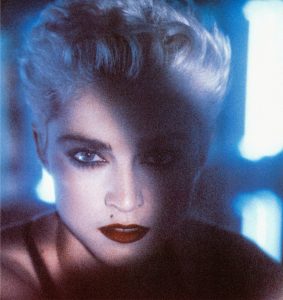Although voyeurism is undoubtedly a negative theme, many artists have decided to “take back the gaze” and reclaim their own bodies in an act of defiance. The first artist to do so was none other than the “Queen of Pop” herself: Madonna. In an industry where female musicians were often pawns to the desires of their producers, Madonna sought to maintain control over her representation. She grew up during the “women’s liberation movement…[which] called upon girls to be career-centered and to seize equality by pursuing the male vision.” (Lewis, 101).1)Lewis, Lisa. “Gender Politics and MTV: Voicing the Difference .” Signs: Journal of Women in Culture and Society, vol. 17, no. 4, 1992, pp. 73–107., doi:10.1086/494773. Madonna expanded upon this notion by challenging the male gaze in a direct way. In “Open Your Heart,” Madonna’s “direct countergaze into the camera lens…makes the audience uncomfortably aware of the voyeuristic aspect of our enjoyment of the performance” (Freccero, 171).2)Freccero, Carla. “Our Lady of MTV: Madonna’s ‘Like a Prayer.’” Boundary 2, vol. 19, no. 2, 1992, p. 163., doi:10.2307/303538.

(A scene from the music video for “Open Your Heart” by Madonna, IMBD)
Madonna was one of the first to pioneer such a response to voyeurism, and the effects of her efforts can be seen today in videos such as Beyonce’s “Check on It.” In the video, Beyonce refutes a voyeuristic camera gaze by gazing at her own behind. While she dances sexually at times, the action of looking at herself before the camera can “takes back” the gaze. Durham notes that the “classy” look of the video combined with the lyrics challenges the hip hop dreamworld’s voyeuristic camera gaze.3)Durham, Aisha. “‘Check On It:” Beyoncé, Southern Booty, and Black Femininities in Music Video.” Feminist Media Studies, vol. 12, no. 1, 2012, pp. 35–49., doi:10.1080/14680777.2011.558346. This action both recognizes the problem of voyeurism amongst hip hop videos, and challenges the audience to become cognoscente of its blatant issues.
(The official music video for Beyonce’s “Check On It,” published by Beyonce on youtube.com. Licensed to YouTube by SME (on behalf of Sony Urban Music/Columbia); BMG Rights Management, Abramus Digital, PEDL, Sony ATV Publishing, UMPG Publishing, UMPI, UBEM, CMRRA, SOLAR Music Rights Management, ASCAP, Warner Chappell, ARESA, EMI Music Publishing, and 21 Music Rights Societies)
Another artist who has furthered the discussion about voyeurism through music videos is Sia, a modern Pop vocalist whose gift for songwriting has garnered her fame. One of Sia’s most famous characteristics is her wearing of a large white and black wig, which covers half her face and denies paparazzi a good look at her facial features. Sia thus keeps her audiences intrigued, distances herself from the image of the modern day celebrity, and avoids physical criticism which often plagues celebrities’ lives. She denies any sort of day-to-day voyeurism that usually occurs when an artist becomes famous. In her music video for “Chandelier,” Sia continues this conversation about voyeurism by challenging the notion of vulnerability. Her music video presents not a diegetic performance of Sia singing, but rather a voyeuristic take on a young girl, dancer Maddie Ziegler, dancing in a nude bodysuit. Sia’s “vulnerability on display is constituted through visual and musical codes,” which unsettles her audience (Hawkins).4)Hawkins, Stan. The Routledge Research Companion to Popular Music and Gender. Routledge, Taylor & Francis Group, 2017.We watch her dance but with a sense of guilt, as we are painfully aware of how young she. Thus, Sia starts a much-needed dialogue about voyeurism, as her audience becomes aware of how the camera angles act as a third party “looking in” on the girl dancing. Because she is so young, however, this “looking in” on her dancing isn’t rewarding.
(The official music video for Sia’s “Chandelier,” published by Sia on youtube.com. Licensed to YouTube by SME (on behalf of Inertia); UBEM, EMI Music Publishing, ASCAP, CMRRA, SOLAR Music Rights Management, UMPI, and 12 Music Rights Societies)
These efforts to “take back” a voyeuristic, male-oriented camera gaze demonstrate a newfound strength arising from the “obsession with obsession.” From Madonna to Sia, artists have taken the detrimental and widespread theme of voyeurism and have turned it into a positive message in their music videos.
References
| ↑1 | Lewis, Lisa. “Gender Politics and MTV: Voicing the Difference .” Signs: Journal of Women in Culture and Society, vol. 17, no. 4, 1992, pp. 73–107., doi:10.1086/494773. |
|---|---|
| ↑2 | Freccero, Carla. “Our Lady of MTV: Madonna’s ‘Like a Prayer.’” Boundary 2, vol. 19, no. 2, 1992, p. 163., doi:10.2307/303538. |
| ↑3 | Durham, Aisha. “‘Check On It:” Beyoncé, Southern Booty, and Black Femininities in Music Video.” Feminist Media Studies, vol. 12, no. 1, 2012, pp. 35–49., doi:10.1080/14680777.2011.558346. |
| ↑4 | Hawkins, Stan. The Routledge Research Companion to Popular Music and Gender. Routledge, Taylor & Francis Group, 2017. |